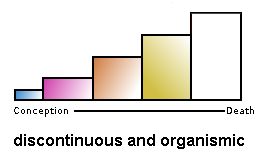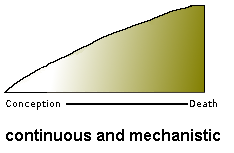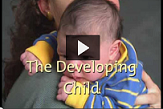Lifespan (1)
Welcome to the first lecture on Lifespan Development.
We’ll be talking in this chapter about how people develop from birth until they die.
This entire section of Introduction to Psychology is also a preview of what you would study in a course in Developmental Psychology.
So for those of you who have to take Developmental Psychology (for instance: Nurses), pay close attention.
Developmental Psychology also called Lifespan Development is the study of how organisms change over time as the result of their biological and environmental influences.
Watch both of the following videos before you continue:
Discovering Psychology Series - "The Developing Child"
Language: Crash Course Psychology #16
I find that older students enjoy the Discovering Psychology video and the younger students like the Crash course videos.
There is an interaction between biology and environment. There are arguments in psychology based around development about which is more important - nature or nurture. Some of my students have trouble with the definitions of Nature and Nurture. To most students the word Nature means the outside world. It is when you’re walking in the woods. It's the birds, the bees and the flowers and the trees - that's the thing called love (it's a song). To many people that is the description of Nature, but to a person in Psychology the word Nature means – YOU - your biology. To a psychologist Nurture is how you have been influenced by the environment. So Nurture is the environment in which you grow and Nature means your biology. The interaction between the two is a process by which the forces work together and influence each other in some way, shape, or form.
An example of the interactions of Nature and Nurture is the Down Syndrome baby. In the past the Down Syndrome baby was looked upon as a person who had no potential; who would never amount to anything in life. That being said they would put a Down Syndrome child into an institution (an asylum) where it was pretty much guaranteed that the child would never amount to anything, because they never gave the child anything but the minimum nutrition, love, education and attention that it needed. They never gave it an environment in which it could flourish and therefore it did not. But, in today’s society, we can keep a Down Syndrome child in the family and give it the love and attention that it needs, give it education, and food and clothing, and anything else that it would need to thrive. In that case the child does thrive. A Down Syndrome child can become a contributing, tax paying member of society. They can hold a job. So it is not specifically the biology alone that determines what a person will be, but the biology and how the environment influences that biology. A Down's syndrome child has a reduced potential compared to a child who has the proper compliment of genes. However, even with the proper genetics a child in an impoverished environment will not reach its potential. So our genes set a specific potential which we may or may not reach. Potential is the best that you can be according to your genes. Very few of us ever reach that potential. The environment from conception through adulthood determines how much of that potential we will achieve.
Nature and Nurture continue to produce changes in personality and mental processes throughout your life cycle. You will continuously adapt and change to your environment. So how do Psychologists explain development? Well, your development is a process of growth and change that’s brought about by the interaction of your heredity and the environment. This leads to the Nature-Nurture controversy which is the long standing dispute over the relative importance of Nature and Nurture and their influences on behavior and mental processes. At one point in time, there were some Scientists declaring that it was all Nature and others who would declare it was all Nurture. Unfortunately people got caught in that cross-fire and were hurt because it is not all one or the other. Development is a combination of both. You cannot take a boy, raise him as a girl, and expect him to be a girl, and yet, there were people who believed that it was possible to do exactly that! They believed gender had nothing to do with nature. They thought it was all in a person's environment and how they were nurtured. So, if you were nurtured as a girl, then you would be a girl. However, that’s not the case as the documentary about the “Boy who was raised as a girl” shows us. Below is a 9 minute presentation about this child. The doctor (Dr. Money from Johns Hopkins in Baltimore Maryland) caused this problem and was eventually disgraced and lost almost all support in the scientific community. There’s no one today that will say that it’s absolutely one way or the other, it’s all Nature or it’s all Nurture. We do know that it’s a combination of the two. However, it is a big issue today to determine which one is more important? Is Nature more important or is Nurture more important.
Most Scientists agree now that there is an interaction between Nature and Nurture. We believe that the two work hand in hand. Heredity establishes your potential and Environment helps to determine how much of that potential will be realized. However, which one is more important?. Of course, we have to ignore the fact that if the Biology didn’t exist, there would be nothing there for the environment to work on. That would make biology(nature) very important!
So the Nature people have a very good reason to claim theirs is the most important. Not withstanding the fact that you have to be born, you have to have a Biology - which is more important after you’re born, your biology, or your environment. Did you know that birth order appears to affect your personality? That’s an environmental factor that you have no control over. You are either the first born, second born, or third born in your family. There is a loose association between the personality of a person and their birth order, and there’s an entire personality theory based on that. Birth order therefore is a part of your environment, and so it shows that even birth order, that little piece of your environment, can play a role in how you are going to develop. The first born son never has to share with anyone. They are the King of the house. When their brother is born they suddenly have a switch in their environment. They are no longer King of the house. They have to share. The second born son always has to share! They never have the experience of being an only child. This leads to different views of the world and different personalities. However, if the second child was a daughter, then she is queen and still has a slightly “only child” view of the world.
Twin studies are used to determine the relative importance of Nature and Nurture. Of course we don’t separate twins on purpose, but unfortunately twins will be separated at birth at times and they will go into adoption agencies. The adoption agency has no intention of keeping the twins together. They will adopt them out to whatever parent comes along and wants them, and is eligible to adopt. Most parents don’t want to adopt two children, so they will adopt one twin to one family and another twin to another family. But, later in life, we can go back and find those twins and we can find out if there’s any difference between the twins. If there is a difference between the twins, those differences will most likely be due to different environmental influences. Their similarities will be due to biology – their similar genetics. The "Twinsburg Twins Days" in Twinsburg, Ohio USA is a festival that was started in 1976 with only 36 sets of twins. It has grown to be the world's largest annual gathering of twins with approximately 3,000 sets attending each year. It is a huge, fun-filled twin weekend - attracting twins, multiples and their families from all over the world, many returning year after year. Scientists descend upon the party to get information from all those twins.
Imagine a caucasion Jewish family has male twins and puts them up for adoption. One child is adopted by an Asian Buddhist family and another by a black Muslim family. Many years later we can compare them. Will their eye colr be different? Of course not. Will their skin color have changed? Nope! How about their religion? Most likely it will be different. How about their height? Maybe so. Why would their height possibly be different? The Muslim family eats meat and the Buddhist family is vegetarian. The nutrition could be different and nutrition affects growth. So developmental investigation in twin studies is where twins, especially identical twins, are compared in the search for genetic and environmental effects. Twins are more similar than other siblings on measures of intelligence, personality, and interests. This means intelligence, personality, and interests have a basis in biology. We say these traits are also somewhat canalized. Canalization is the amount a genotype is resistant to the environment, which means that a highly canalized genotype (like eye color and skin color) is only very minimally influenced by the environment, and a weakly canalized genotype (like height) is easily adapted to the environment. Your hair color is highly canalized. It doesn’t matter what kind of food you’re fed, doesn’t matter what kind of house you grow up in, doesn’t matter what kind of religion you are, your hair’s going to be the same color unless you use a bottle to change it. It is the same with your eyes. Eye color is eye color, and there’s nothing that you can do to change that. We say it is very canalized. How about your thought processes? They are very weakly canalized if they have any relationship to genetics at all! However, your height is only slightly canalized. You are born with a specific potential to be a specific height. Whether you reach that height will be dependent upon how many calories you get, how many carbohydrates you get, how much exercise you get, how many liquids you get and your intake of vitamins and minerals. All of that is a part of your environment and your environment plays a role in how tall you’re going to be.
Genetics
account for about 20 to 60 percent of your verbal, spatial, and
perceptual abilities. Which means that the
rest has to do with the environment. Other adoption studies used
to determine the relative importance of Nature and Nurture find other
siblings that are not identical and compare them. Siblings that are
related but not twins should be genetically 50 percent alike. They
will share about 50 percent of their genes if they have the same
mother and father. OK, I have to emphasize that they are 50% the same ONLY if they have the same father! A woman can be very "active" and have fraternal twins with different fathers! They they are only 25% genetically identical. When adopted they may go to different environments and
again we will look to see what is the same about them and what is
different about them. All these studies compare the adopted children’s
characteristics to those of their biological family (their Sires) and their adopted family. We look at
them to see how similar they are to each other, and how similar they
are to their adopted family and their sires.
Their adopted family will be close to them in certain situations, but
in other things they’ll be more similar to their biological family.
Whatever traits or behaviors or appearances that are more similar to
their biological families will be based on genetics. Those things that
are more similar to their adopted family will be related to
environment.
Through these studies we know that heredity can play a role in a variety of mental disorders, that’s why we’re talking about it. We are in Psychology! Genetics plays a role in the potential to abuse alcohol, Alzheimer’s disease, Schizophrenia, depression and panic disorder. All of these are influenced by genetics (nature) in some way, shape or form, but you can’t discount the environment’s ability to interact with that condition - or the potential that you might have that condition. Even an identical twin, which has a twin that’s schizophrenic, may not get schizophrenia. If you have an identical twin that has schizophrenia, there’s only a 50 percent chance that you will get schizophrenia. This shows it is not all genetic and there is some environmental factors that are involved. In the Psychopathology unit we will talk about identical twins in England where one has schizophrenia and the other does not and discuss the reasons why.


The continuity view says that development is gradual and continuous. The discontinuity view says that development proceeds in uneven steps; and the developmental stages of life, the periods of life that are initiated by significant transitions or changes in physical or psychological functioning, occur in leaps rather than smoothly. The changes in outward appearance at Puberty, again, as I said, is a good example of one of these stages. Later we will discuss some very stage oriented theories.
Development can be caused by self-fulfilling prophecies. We have to accept that we do have influence over our own lives. The self-fulfilling prophecies are expectations that become reality because the prophecy that we have in our heads guides the believer’s behavior. So if parents believe that their child is shy then they act towards their child like they are shy. The parents behave in all ways, shapes, and form like the child is shy. They protect the child from environments where you think the child will suffer and most probably the child will end up being shy! The child may not have been shy at first, but the parents made them that way through their behavior toward the child. This is a self fulfilling prophecy! If you act towards your child like they are intelligent, and good, and wonderful, then most likely they will grow up to be intelligent, good, and wonderful.
That's it for this lecture.
I’m going to stop here. It's time for a break guys, and gals. Go get a cup of coffee.
Go do something other than study (maybe play the hangman game).
There is one crossword puzzle for the entire unit,
but the hangman games are made for each slide.
Take 15 minutes or so before you go to the next slide.
Distributed learning is the best learning.
We will continue the study of the Lifespan in the next lecture.
Talk with you then.
